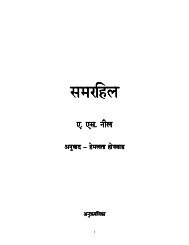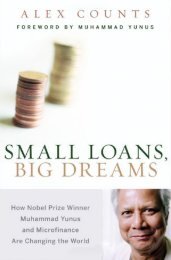FLIGHT OF THE HUMMINGBIRD (A Parable for the ... - Vidya Online
FLIGHT OF THE HUMMINGBIRD (A Parable for the ... - Vidya Online
FLIGHT OF THE HUMMINGBIRD (A Parable for the ... - Vidya Online
You also want an ePaper? Increase the reach of your titles
YUMPU automatically turns print PDFs into web optimized ePapers that Google loves.
<strong>FLIGHT</strong> <strong>OF</strong> <strong>THE</strong> <strong>HUMMINGBIRD</strong><br />
(A <strong>Parable</strong> <strong>for</strong> <strong>the</strong> Environment)
FOREWORD<br />
Wangari Maathai<br />
WISDOM <strong>OF</strong> <strong>THE</strong> <strong>HUMMINGBIRD</strong><br />
NEARLY thirty years ago, I planted seven trees in Kenya. These seven trees led to <strong>the</strong><br />
creation of <strong>the</strong> Green Belt Movement. Since <strong>the</strong>n, I have worked with women and men who<br />
have planted more than 30 million trees across Kenya, and we have shared our mission with<br />
many o<strong>the</strong>r countries in Africa.<br />
Through <strong>the</strong> Green Belt Movement, thousands of communities, largely poor and rural,<br />
have been able to transcend ignorance and fear and take positive action <strong>for</strong> <strong>the</strong> earth. In <strong>the</strong><br />
process, <strong>the</strong>y have also secured <strong>the</strong>ir own livelihoods, as <strong>the</strong> trees provide <strong>the</strong>m with fuel,<br />
fodder, protection against soil erosion, and even a small income.<br />
One of <strong>the</strong> most important lessons I have learned is that all citizens need to be<br />
empowered. We need to feel that <strong>the</strong> life we want <strong>for</strong> ourselves and our children can be<br />
achieved only when we directly participate in protecting and restoring our environment. We<br />
can’t wait <strong>for</strong> o<strong>the</strong>rs to do it <strong>for</strong> us; we need to take action ourselves.<br />
In Japan I learned <strong>the</strong> Buddhist word mottainai. It embraces <strong>the</strong> practice of not wasting<br />
resources and of using <strong>the</strong>m with respect and gratitude. I have been sharing that word,<br />
mottainai, wherever I go because I think it’s a beautiful word, and it also captures in one<br />
term <strong>the</strong> “three Rs” that environmentalists have been campaigning on <strong>for</strong> a number of years:<br />
reduce, reuse, and recycle. I am seeking to make mottainai a global campaign, adding one<br />
more “R” suggested by Klaus Topfer, <strong>the</strong> head of <strong>the</strong> United Nations Environment Program:<br />
“repair” resources where necessary. I have been consciously practicing <strong>the</strong> four Rs.
We can practice mottainai in rich countries where over consumption is rampant, and we<br />
can also do it in regions where environmental devastation is causing <strong>the</strong> poor to get poorer<br />
and <strong>the</strong> ecosystems on which <strong>the</strong>y depend to be degraded, some beyond repair.<br />
In my case, mottainai means continuing to plant trees, particularly now that <strong>the</strong> long rains<br />
have come to Kenya. I have also called on my parliamentary colleagues to ensure that<br />
government offices use both sides of each sheet of paper so that we can halve <strong>the</strong> amount of<br />
paper we consume.<br />
And I am urging <strong>the</strong> public and manufacturers not to use plastic bags that are so thin <strong>the</strong>y<br />
tear almost immediately or are used once and thrown away. These bags clog waste dumps<br />
and blight <strong>the</strong> landscape in Kenya and around <strong>the</strong> world. They also provide good breeding<br />
grounds <strong>for</strong> disease-carrying mosquitoes.<br />
If we did not use <strong>the</strong>se bags, and instead carried our shopping in long-lasting and<br />
environmentally friendly containers such as kiondos and o<strong>the</strong>r baskets, we could revitalize<br />
traditional industries like basket and cloth weaving. This could become a global trend. If<br />
Kenya began exporting to developed countries at a fair price millions of kiondos woven by<br />
women from sustainably harvested sisal plants, that would be an important contribution to <strong>the</strong><br />
protection of <strong>the</strong> earth, to rural livelihoods, and to fair trade.<br />
We could also walk or use bicycles when we can, and avoid excessive use of airplanes.<br />
These arc just a few examples. There are many o<strong>the</strong>rs relevant to your life, your<br />
community, and your country.<br />
We sometimes underestimate what we can accomplish as individuals, but <strong>the</strong>re is always<br />
something we can do. Like <strong>the</strong> little hummingbird in <strong>the</strong> story that follows, we must not allow<br />
ourselves to become overwhelmed, and we must not rest. This is what we are called to do.<br />
Today and every day let us dedicate ourselves to making mottainai a reality. It is our human<br />
responsibility to appreciate nature and to preserve and protect <strong>the</strong> world’s natural resources.<br />
We can all be like <strong>the</strong> hummingbird, doing <strong>the</strong> best we can.
HERE IS <strong>THE</strong> STORY<br />
<strong>OF</strong> <strong>THE</strong> GREAT FOREST<br />
THAT CAUGHT ON FIRE.<br />
The terrible fire raged and burned.<br />
All of <strong>the</strong> animals were afraid and fled from <strong>the</strong>ir homes. The elephant and <strong>the</strong> tiger, <strong>the</strong><br />
beaver and <strong>the</strong> bear all ran, and above <strong>the</strong>m <strong>the</strong> birds flew in a panic.
They huddled at <strong>the</strong> edge of <strong>the</strong> <strong>for</strong>est and watched.<br />
All of <strong>the</strong> creatures ga<strong>the</strong>red, except one.
Only Dukdukdiya, <strong>the</strong> little hummingbird,<br />
would not abandon <strong>the</strong> <strong>for</strong>est. Dukdukdiya flew<br />
quickly to <strong>the</strong> stream. She picked up a single<br />
drop of water in her beak.
Dukdukdiya flew back and dropped <strong>the</strong><br />
water on <strong>the</strong> fire.
Again she flew to <strong>the</strong> stream and brought back ano<strong>the</strong>r drop, and so she<br />
continued—back and <strong>for</strong>th, back and <strong>for</strong>th.<br />
The o<strong>the</strong>r animals watched Dukdukdiya’s tiny body fly against <strong>the</strong> enormous<br />
fire, and <strong>the</strong>y were frightened. They called out to <strong>the</strong> little hummingbird, warning<br />
her of <strong>the</strong> dangers of <strong>the</strong> smoke and <strong>the</strong> heat.<br />
“What can I do” sobbed <strong>the</strong> rabbit. “This fire is much too hot.”<br />
“There is too much smoke!” howled <strong>the</strong> wolf.
“My wings will burn! My beak is too<br />
small!” cried <strong>the</strong> owl.<br />
But <strong>the</strong> little hummingbird persisted. She<br />
flew to and fro, picking up more water and<br />
dropping it, bead by bead, onto <strong>the</strong> burning<br />
<strong>for</strong>est.
Finally, <strong>the</strong> big bear said, “Little Dukdukdiya,<br />
what are you doing”
Without stopping, Dukdukdiya looked down at<br />
all of <strong>the</strong> animals. She said, “I am doing what I<br />
can.”<br />
<strong>THE</strong> <strong>HUMMINGBIRD</strong>’S EFFECT<br />
THIS story of a small, committed bird determined to put out a <strong>for</strong>est<br />
fire is inspired by a parable told by <strong>the</strong> Quechuan people of present-day<br />
Ecuador. The hummingbird is a frequent character in <strong>the</strong> stories of <strong>the</strong><br />
indigenous peoples of <strong>the</strong> Americas, <strong>the</strong> exclusive home of more than<br />
350 species of <strong>the</strong> extraordinary little bird.
The hummingbird often symbolizes beauty and agility, as well as optimism, wisdom, and<br />
<strong>the</strong> celebration of life. Spotting a hummingbird is usually cause <strong>for</strong> joy and a sign of good<br />
things to come. The Aztec deity Huitzilopochtli is often depicted as a hummingbird, and <strong>the</strong><br />
Aztec people believed that dead warriors are reincarnated as hummingbirds. To <strong>the</strong> Chayma<br />
people of Trinidad, hummingbirds are dead ancestors, so <strong>the</strong>re is a taboo against harming<br />
<strong>the</strong>m.<br />
The Mayan of Central America say <strong>the</strong> hummingbird is actually <strong>the</strong> sun in disguise, and he<br />
is trying to court his beloved, who is <strong>the</strong> moon. The Jatibonicu Taino Nation of Puerto Rico<br />
tells <strong>the</strong> tragic story of young lovers from rival families; <strong>the</strong>ir situation is memorialized when<br />
one becomes a hummingbird and <strong>the</strong> o<strong>the</strong>r a bright-red flower.<br />
Fire, rain, and water are frequent elements in hummingbird stories. The hummingbird is<br />
said to have been born from fire, which explains its marvelous fiery fea<strong>the</strong>rs, while o<strong>the</strong>r<br />
stories suggest that it was <strong>the</strong> hummingbird who brought fire to <strong>the</strong> earth.<br />
The Hopi and Zuni ask <strong>the</strong> hummingbirds to intervene on <strong>the</strong>ir behalf to persuade <strong>the</strong><br />
gods to bring rain. In thanks, <strong>the</strong>se peoples often paint hummingbirds on <strong>the</strong>ir water jars.<br />
There is a parable from <strong>the</strong> Tarascan Nation of Mexico about a woman who is taught how to<br />
weave beautiful baskets by a grateful hummingbird to whom she had given sugar water during<br />
a drought.<br />
The Pueblo Indians celebrate hummingbird dances and use hummingbird fea<strong>the</strong>rs in<br />
rituals to bring rain. One Pueblo story tells of a demon who is blinded after losing a bet with<br />
<strong>the</strong> sun. In auger he spews out hot lava and causes <strong>the</strong> earth to catch fire. A hummingbird<br />
ga<strong>the</strong>rs clouds from <strong>the</strong> four directions to bring rain, which puts out <strong>the</strong> flames. The bright<br />
colors on a hummingbird’s throat remind us that he fled <strong>the</strong> fire through a rainbow.<br />
The Mojave recount <strong>the</strong> path finding skills of this small creature. During a time when <strong>the</strong><br />
people lived in an underground world of darkness, <strong>the</strong>y sent a hummingbird to look <strong>for</strong> light.<br />
High above <strong>the</strong>m, <strong>the</strong> bird found a path to <strong>the</strong> sunlit upper world where <strong>the</strong> people now live.
The Haida Nation of <strong>the</strong> North Pacific call <strong>the</strong> hummingbird dukdukdiya, in imitation of<br />
<strong>the</strong> small bird’s voice. They tell <strong>the</strong> story of Haida explorers who had traveled offshore in a<br />
canoe <strong>for</strong> two months be<strong>for</strong>e discovering a peopled land where many bees and birds,<br />
including <strong>the</strong> hummingbird, lived in caves. For four years <strong>the</strong> travelers stayed in this land, but<br />
when <strong>the</strong> hummingbird flew out of <strong>the</strong> caves, <strong>the</strong> Haida also left and returned home.<br />
As with Dukdukdiya in <strong>the</strong> burning <strong>for</strong>est and <strong>the</strong> hummingbirds that populate <strong>the</strong> stories<br />
and parables of many peoples, it’s not necessarily <strong>the</strong> largest, most courageous, or loudest<br />
animal that can do <strong>the</strong> most good or have <strong>the</strong> greatest influence. Ra<strong>the</strong>r, those who are not<br />
afraid to act, and who are aware of what is at stake, can make <strong>the</strong> biggest difference.<br />
Michelle Benjamin<br />
AFTERWORD<br />
His Holiness <strong>the</strong> Dalai Lama<br />
UNIVERSAL<br />
RESPONSIBILITY<br />
As a boy studying Buddhism, I was taught <strong>the</strong> importance of a caring attitude toward <strong>the</strong><br />
environment. In Buddhism, our practice of nonviolence and <strong>the</strong> ending of all suffering means<br />
that we become accustomed to not harming or destroying anything indiscriminately. Just as<br />
we should cultivate gentle and peaceful relations with our fellow human beings, we should<br />
also extend that attitude toward <strong>the</strong> natural environment. We share a sense of universal<br />
responsibility <strong>for</strong> both humankind and nature.
The survival of life on earth as we know it is threatened by human activities that lack a<br />
commitment to nonviolence and humanitarian values. The environment—<strong>the</strong> source of life <strong>for</strong><br />
all beings in <strong>the</strong> world—continues to undergo extensive degeneration, and this destruction of<br />
nature and <strong>the</strong> earth’s natural resources results from ignorance, greed, and lack of respect <strong>for</strong><br />
<strong>the</strong> earth’s living things. This lack of respect extends even to <strong>the</strong> earth’s human descendants.<br />
These future generations will inherit a vastly degraded planet if destruction of <strong>the</strong> natural<br />
environment continues at <strong>the</strong> present rate.<br />
Our ancestors viewed <strong>the</strong> earth as rich and bountiful, which it is. Many people in <strong>the</strong> past<br />
also saw nature as inexhaustibly sustainable, which we know is <strong>the</strong> case—but only if we care<br />
<strong>for</strong> it. We must consider future generations: a clean environment is a human right like any<br />
o<strong>the</strong>r. If we exploit <strong>the</strong> environment in extreme ways, even though we may get some money or<br />
o<strong>the</strong>r benefit from it now, in <strong>the</strong> long run we ourselves will suffer and future generations will<br />
suffer. It is <strong>the</strong>re<strong>for</strong>e part of our responsibility toward o<strong>the</strong>rs to ensure that <strong>the</strong> world we pass<br />
on is as healthy as when we found it, if not healthier.<br />
Of course, when we say “us” or “humanity” or “society,” it’s obvious <strong>the</strong> initiative must<br />
come from individuals. Large human movements spring from individual human ef<strong>for</strong>ts. Yes,<br />
one individual can change <strong>the</strong> world! The problems resulting from our neglect of our natural<br />
environment are a powerful reminder that we all have a contribution to make. And while one<br />
person’s actions alone may not have a significant impact, <strong>the</strong> combined effect of millions of<br />
individuals’ actions certainly does. First, it is important to realize we are part of nature.<br />
Ultimately, nature will always be more powerful than human beings, even with all our nuclear<br />
weapons, scientific equipment, and knowledge. If <strong>the</strong> sun disappears or <strong>the</strong> earth’s<br />
temperature changes by a few degrees, <strong>the</strong>n we are really in trouble.<br />
At a deeper level, we .should recognize that although we are part of nature, we can<br />
control and change things through our intelligence. Among <strong>the</strong> thousands of species of<br />
mammals on earth, we humans have <strong>the</strong> greatest capacity to alter nature. As such, we have a<br />
twofold responsibility. Morally, as beings of higher intelligence, we must care <strong>for</strong> this world.<br />
The o<strong>the</strong>r Inhabitants of <strong>the</strong> planet—insects and hummingbirds and so on—do not have <strong>the</strong><br />
means to save or protect this world. Our o<strong>the</strong>r responsibility is to undo <strong>the</strong> serious<br />
environmental degradation that is <strong>the</strong> result of incorrect human behavior. We have recklessly<br />
polluted <strong>the</strong> world with chemicals and nuclear waste, selfishly consuming many of its<br />
resources. Humanity—and every individual within that—must take <strong>the</strong> initiative to repair and<br />
protect <strong>the</strong> world.<br />
In order to succeed in <strong>the</strong> protection and conservation of <strong>the</strong> natural environment, it is<br />
important first of all to bring about an internal balance within human beings <strong>the</strong>mselves. The<br />
abuse of <strong>the</strong> environment arose out of ignorance. It is essential to help people to understand<br />
this. I try always to express <strong>the</strong> value of having a good heart. This simple aspect of human<br />
nature can be nourished to great power.
With a good heart and wisdom you have <strong>the</strong> right<br />
motivation and will automatically do what needs to be done.<br />
If people begin to act with genuine compassion <strong>for</strong> everyone,<br />
we can still protect each o<strong>the</strong>r and <strong>the</strong> natural environment.<br />
This is much easier than having to adapt to <strong>the</strong> severe and<br />
incomprehensible environmental conditions projected <strong>for</strong> <strong>the</strong><br />
future.<br />
It is up to us as individuals to do what we can, however<br />
little that may be. Just because switching off <strong>the</strong> light when<br />
leaving a room seems inconsequential, it does not mean that<br />
we should not do it. Similarly, it is inappropriate to randomly<br />
discard fruit peels, paper, plastic bottles, old clo<strong>the</strong>s, food<br />
leftovers and o<strong>the</strong>r kinds of garbage. Such things spoil <strong>the</strong><br />
beauty of <strong>the</strong> landscape and are a hazard to health and<br />
hygiene.<br />
Also, I have remarked on several occasions about <strong>the</strong><br />
importance of tree planting. According to accounts of <strong>the</strong><br />
Buddha’s life, it would appear that he had a very deep<br />
relationship with nature and especially with trees. He was not<br />
born in <strong>the</strong> royal palace but in a park, under a sala tree. He<br />
attained complete enlightenment under <strong>the</strong> bodhi tree and left<br />
this earth to enter nirvana between three sala trees. It would<br />
seem that <strong>the</strong> Buddha was very fond of trees.<br />
Fortunately, <strong>the</strong> movement toward a deeper commitment to environmental protection<br />
through planting new trees and taking care of <strong>the</strong> existing ones is rapidly increasing all over<br />
<strong>the</strong> world. At a global level, trees and <strong>for</strong>ests are closely linked with wea<strong>the</strong>r patterns and <strong>the</strong><br />
maintenance of a crucial balance in nature. A healthy tree purifies <strong>the</strong> air and supplies oxygen<br />
<strong>for</strong> living beings to brea<strong>the</strong>. It harmonizes <strong>the</strong> elements and increases life expectancy. Its<br />
shade provides a refreshing place to rest. It nourishes crops and livestock and balances <strong>the</strong><br />
temperature. It contributes to an attractive landscape and continually replenishes its<br />
surroundings.<br />
I always stress <strong>the</strong> need to consider how our actions, in affecting <strong>the</strong> environment, are<br />
likely to affect o<strong>the</strong>rs. I admit that this is very often difficult to judge. We cannot say <strong>for</strong> sure<br />
what <strong>the</strong> ultimate effects of, <strong>for</strong> example, de<strong>for</strong>estation might be on <strong>the</strong> soil and <strong>the</strong> local<br />
rainfall, let alone what <strong>the</strong> implications are <strong>for</strong> <strong>the</strong> planet’s wea<strong>the</strong>r systems. The only clear<br />
thing is that we humans are <strong>the</strong> only species with <strong>the</strong> power to destroy <strong>the</strong> earth as we know<br />
it. The birds have no such power, nor do <strong>the</strong> insects, nor does any o<strong>the</strong>r mammal. Yet if we<br />
have <strong>the</strong> capacity to destroy <strong>the</strong> earth, so, too, do we have <strong>the</strong> capacity to protect it.
The key thing is a sense of universal responsibility; that is <strong>the</strong> real source of strength, <strong>the</strong><br />
real source of happiness. If our generation exploits everything available—<strong>the</strong> trees, <strong>the</strong> water,<br />
and <strong>the</strong> minerals—without any care <strong>for</strong> <strong>the</strong> coming generations or <strong>the</strong> future, <strong>the</strong>n we are at<br />
fault, aren’t we But if we have a genuine sense of universal responsibility as our central<br />
motivation, <strong>the</strong>n our relations with our neighbors, both domestic and international, will<br />
improve.<br />
This need <strong>for</strong> a sense of universal responsibility affects every aspect of modern life.<br />
Nowadays, significant events in one part of <strong>the</strong> world eventually affect <strong>the</strong> entire planet.<br />
There<strong>for</strong>e, we have to treat each local problem as a global concern from <strong>the</strong> moment it<br />
begins. We can no longer invoke <strong>the</strong> national, racial, or ideological barriers that separate us<br />
without prompting destructive repercussions.<br />
Whe<strong>the</strong>r we like it or not, we have been born on this earth as part of one great family.<br />
Rich or poor, educated or uneducated, belonging to one nation or ideology or ano<strong>the</strong>r,<br />
ultimately each of us is just a human being like everyone else. Fur<strong>the</strong>rmore, each of us has <strong>the</strong><br />
same right to pursue happiness and avoid suffering. When you recognize that all beings are<br />
equal in this respect, you automatically feel empathy and closeness <strong>for</strong> <strong>the</strong>m.<br />
Of course, this sort of compassion is, by nature, peaceful and gentle, but it is also very<br />
powerful. It is <strong>the</strong> true sign of inner strength. We do not need to become religious, nor do we<br />
need to believe in an ideology. In <strong>the</strong> context of our interdependence, considering <strong>the</strong> interests<br />
of o<strong>the</strong>rs is clearly <strong>the</strong> best <strong>for</strong>m of self-interest. All that is necessary is <strong>for</strong> each of us to<br />
develop our good human qualities.<br />
We need to teach people that <strong>the</strong> environment has a direct bearing on our own benefit. We<br />
must teach people to understand <strong>the</strong> need <strong>for</strong> environmental protection. We must teach<br />
people that conservation directly aids our survival. Besides, <strong>the</strong> environment does not need<br />
fixing. It is our behavior in relation to it that needs to change. The air we brea<strong>the</strong>, <strong>the</strong> water we<br />
drink, <strong>the</strong> <strong>for</strong>ests and oceans that sustain millions of different life <strong>for</strong>ms, and <strong>the</strong> climatic<br />
patterns that govern our wea<strong>the</strong>r systems all transcend national boundaries. This is a source<br />
of hope. It means that no country, no matter ei<strong>the</strong>r how rich and powerful or how poor and<br />
weak, can af<strong>for</strong>d to not take action.<br />
Ultimately, <strong>the</strong> decision to save <strong>the</strong> environment must come from <strong>the</strong> human heart. I want<br />
to tell you that self-confidence and enthusiasm are <strong>the</strong> keys to a successful life and to<br />
.success in any activity one is engaged in. We must be determined and must have an<br />
optimistic outlook; <strong>the</strong>n, even if we fail, we will have no regrets. Once you have made up your<br />
mind, you must go <strong>for</strong>ward with a single-minded devotion in spite of <strong>the</strong> obstacles. This is<br />
very important.<br />
Clearly this is a pivotal generation. Our beautiful world is facing many crises. It is not a<br />
time to pretend everything’s good. Global communication is possible, yet confrontations take<br />
place more often than meaningful dialogues <strong>for</strong> peace. Our marvels of science and technology<br />
are matched, if not outweighed, by many current tragedies, including human starvation in
some parts of <strong>the</strong> world and extinction of o<strong>the</strong>r life <strong>for</strong>ms. Exploration of outer space takes<br />
place at <strong>the</strong> same time <strong>the</strong> earth’s own oceans, seas, and freshwater areas grow increasingly<br />
polluted, and <strong>the</strong>ir life <strong>for</strong>ms are still largely unknown or misunderstood. Many of <strong>the</strong> earth’s<br />
habitats, animals, plants, insects and even micro-organism s that we know as rare may not be<br />
known at all by future generations.<br />
However, I feel optimistic about <strong>the</strong> future. The rapid changes in our attitude toward <strong>the</strong><br />
earth are a source of hope. As recently as a decade ago, we thoughtlessly devoured <strong>the</strong><br />
resources of <strong>the</strong> world as if <strong>the</strong>re were no end to <strong>the</strong>m. Now, both individuals and<br />
governments are seeking a new ecological and economic order. We have <strong>the</strong> capability and<br />
<strong>the</strong> responsibility. We must take into account that great love and great achievements involve<br />
great risk. We must act be<strong>for</strong>e it is too late.<br />
Michael Nicoll Yahgulanaas<br />
A SINGLE BEAD <strong>OF</strong> WATER<br />
<strong>FLIGHT</strong> is not exclusive to a single species, nor is <strong>the</strong> ability to fly restricted to those with<br />
<strong>the</strong> greatest wingspan. Just as many creatures—known and unknown—can fly, <strong>the</strong><br />
accomplishment of great deeds is not <strong>the</strong> sole domain of <strong>the</strong> largest, <strong>the</strong> most dominant, or<br />
even <strong>the</strong> most apparent. The tiniest of notions can fly.<br />
In Haida stories it is often <strong>the</strong> most diminutive creature — a mouse, a frog, or even that<br />
curious being that becomes .smaller <strong>the</strong> closer it approaches— that offers <strong>the</strong> critical gift or<br />
<strong>the</strong> necessary solution. One of our foundational narratives describes a dark time when all <strong>the</strong><br />
light in <strong>the</strong> universe is stored away inside <strong>the</strong> smallest container and is released only when <strong>the</strong><br />
greatest hero becomes a small child. The wee creatures don’t seek a lofty status, but <strong>the</strong>ir<br />
humble contributions, even a single bead of water, allow <strong>for</strong> heroic events.
Solutions to <strong>the</strong> numerous challenges in our lives arc not usually delivered by a thousand<br />
warriors marching to a hundred drums and led by a grand general. Effective responses are<br />
often small and immediately appropriate — <strong>the</strong> acts that we as individuals are entirely capable<br />
of undertaking.<br />
When we put away <strong>the</strong> notion that greatness is essential to success, <strong>the</strong>n we expand into<br />
our full capacity. The hummingbird’s faith in <strong>the</strong> power of <strong>the</strong> small, and in herself, is<br />
illustrated by her heroic contribution — <strong>the</strong> act of simply doing what she can, alone.<br />
Imagine that many, most, or even all of <strong>the</strong> animals also did what <strong>the</strong>y could. They might<br />
never know whe<strong>the</strong>r <strong>the</strong> problem was solved by <strong>the</strong>ir individual ef<strong>for</strong>ts, but <strong>the</strong>ir contribution<br />
would increase <strong>the</strong> likelihood that many beads of water would overcome <strong>the</strong> fire.<br />
But that’s ano<strong>the</strong>r story.<br />
BIOGRAPHY<br />
Wangari Maathai<br />
WANGARI Muta Maathai was born in Nyeri, Kenya, in 1940, <strong>the</strong> daughter of farmers in <strong>the</strong><br />
highlands of Mount Kenya. She is <strong>the</strong> founder of <strong>the</strong> Green Belt Movement, which through<br />
networks of rural women has planted over 30 million trees across Kenya since 1977. In ig86<br />
<strong>the</strong> Movement established a Pan-African Green Belt Network that has taught people from<br />
o<strong>the</strong>r African countries about <strong>the</strong> Green Belt Movement’s approach to environmental<br />
conservation and community building.<br />
Several African countries have since started similar successful initiatives.<br />
Wangari Maathai is internationally recognized <strong>for</strong> her persistent struggle <strong>for</strong> democracy,<br />
human rights, and environmental conservation. She has addressed <strong>the</strong> United Nations on<br />
several occasions, and she spoke on behalf of women at special sessions of <strong>the</strong> General<br />
Assembly <strong>for</strong> <strong>the</strong> five-year review of <strong>the</strong> 1992 Earth Summit. She has served on <strong>the</strong> United<br />
Nations Commission <strong>for</strong> Global Governance and co-chaired <strong>the</strong> Jubilee 2000 Africa<br />
Campaign. She and <strong>the</strong> Green Belt Movement have received numerous international awards,<br />
most notably <strong>the</strong> 2004 Nobel Peace Prize. Professor Maathai serves on <strong>the</strong> boards of several<br />
organizations, including <strong>the</strong> UN Secretary General’s Advisory Board on Disarmament, <strong>the</strong><br />
Women’s Environment and Development Organization, World Learning (USA), Green Cross<br />
International, Environment Liaison Centre International, <strong>the</strong> WorldWIDE Network of Women<br />
in Environmental Work, and <strong>the</strong> National Council of Women of Kenya.<br />
In 2002 Maathai was elected to Kenya’s Parliament in <strong>the</strong> first free elections in a<br />
generation, and in 2003 she was appointed assistant minister <strong>for</strong> <strong>the</strong> environment. In 2005 she<br />
was elected presiding officer of <strong>the</strong> Economic, Social and Cultural Council of <strong>the</strong> African<br />
Union. Eleven African heads of Ktate also appointed her a goodwill ambassador <strong>for</strong> <strong>the</strong>
Congo Basin <strong>for</strong>est ecosystem, an advocacy role <strong>for</strong> <strong>the</strong> conservation and protection of this<br />
vital zone.<br />
Professor Maathai is <strong>the</strong> mo<strong>the</strong>r of three children. She has published three books:<br />
Unbowed: A Memoir, The Green Belt Movement; Sharing <strong>the</strong> Approach and <strong>the</strong><br />
Experience, and The Canopy of Hope: My Life Campaigning <strong>for</strong> Africa, Women, and <strong>the</strong><br />
Environment. She lives and works in Nairobi.<br />
Portions of this biography are drawn from www.wangarimaathai.com<br />
BIOGRAPHY<br />
His Holiness <strong>the</strong> Fourteenth Dalai Lama<br />
HIS HOLINESS <strong>the</strong> Fourteenth Dalai Lama, Tenzin Gyatso, is <strong>the</strong> head of state and <strong>the</strong><br />
spiritual leader of <strong>the</strong> Tibetan people. He was born on July 6, 1935, to a farming family in a<br />
small hamlet in Taktser, nor<strong>the</strong>astern Tibet. At <strong>the</strong> age of two, in accordance with Tibetan<br />
tradition, he was recognized as <strong>the</strong> reincarnation of his predecessor, <strong>the</strong> Thirteenth Dalai<br />
Lama.<br />
His Holiness began his monastic education at <strong>the</strong> age of six. At twenty-three, in 1959, he<br />
sat his final examination in <strong>the</strong> Jokhang Temple, Lhasa, during <strong>the</strong> annual Monlam (Prayer)<br />
Festival. He passed with honors and was awarded <strong>the</strong> Geshe Lharampa degree, equivalent to<br />
a doctorate in Buddhist philosophy.<br />
In 1950, after China’s invasion of Tibet, <strong>the</strong> fifteen-year-old Dalai Lama was called upon<br />
to assume full political power. In 1954 he went to Beijing <strong>for</strong> peace talks with Mao Tse-tung<br />
and o<strong>the</strong>r Chinese leaders, but in 1959 he was <strong>for</strong>ced to escape into exile. Since <strong>the</strong>n he has<br />
been living in Dharamsala, nor<strong>the</strong>rn India, <strong>the</strong> seat of <strong>the</strong> Tibetan political administration in<br />
exile and <strong>the</strong> home of many thousands of Tibetans in exile.<br />
His Holiness is devoted to peace. In 1989 he was awarded <strong>the</strong> Nobel Peace Prize <strong>for</strong> his<br />
nonviolent struggle <strong>for</strong> <strong>the</strong> liberation of Tibet. He has consistently advocated policies of<br />
nonviolence, and he also became <strong>the</strong> first Nobel laureate to be recognized <strong>for</strong> his concern <strong>for</strong><br />
global environmental problems.<br />
The Dalai Lama has traveled to more than sixty-two countries spanning .six continents.<br />
He has met with presidents, prime ministers, and rulers of major nations. He has held<br />
dialogues with <strong>the</strong> heads of many different religions and many well-known scientists. He has<br />
presented his message of peace and compassion to millions of followers worldwide and has<br />
introduced popular Buddhist concepts to <strong>the</strong> West.<br />
Since 1959 His Holiness has received over eighty-four awards, honorary doctorates, and<br />
prizes in recognition of his message of peace, nonviolence, inter religious understanding,<br />
universal responsibility, and compassion. He has authored more than seventy-two books,<br />
many of <strong>the</strong>m international best sellers. He describes himself as “a simple Buddhist monk.”<br />
Portions of this biography are drawn from www.dalailama.com
BIOGRAPHY<br />
Michael Nicoll Yahgulanaas<br />
MICHAEL Nicoll Yahgulanaas, an artist <strong>for</strong>mally trained in Haida design, is translating this<br />
traditional indigenous iconography into contemporary signs. He has developed a new genre—<br />
Haida Manga—that reflects both his indigenous and colonial heritages and is influenced by<br />
his long and active career in social and environmental justice issues on his home islands of<br />
Haida Gwaii and throughout <strong>the</strong> Pacific Rim. His socially relevant work has been<br />
enthusiastically received in Japan and Korea and is published in Japan, Hong Kong, Taiwan,<br />
Macao, and Canada. He has exhibited in Asia and Europe and, most recently, in North<br />
America.<br />
Michael’s body of artistic works includes installation, sculpture, canvas, and paper, and in<br />
his words it features “an enthused and unusually joyful deflation of our serious selves.” He<br />
lives in Canada and is currently working on a full-length Haida Manga book scheduled to be<br />
released in 2009.


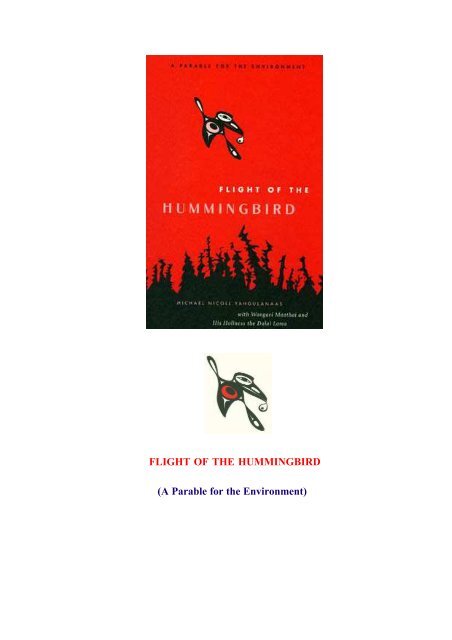

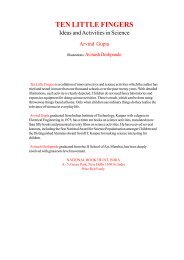
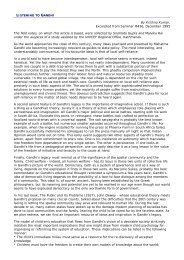
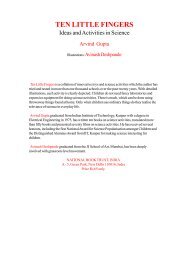


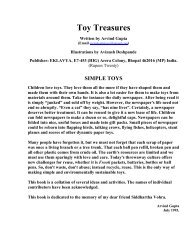
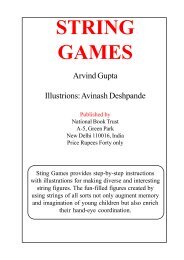

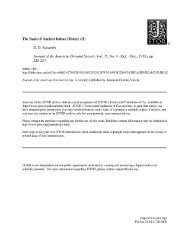
![tq,a] diM+s vkSj vk/qfud ekuo - Vidya Online](https://img.yumpu.com/31264147/1/190x245/tqa-dim-s-vksj-vk-qfud-ekuo-vidya-online.jpg?quality=85)

